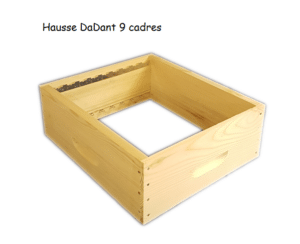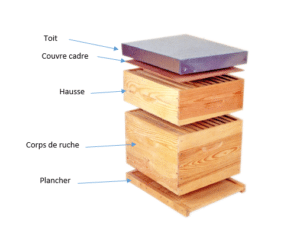How to maintain a beehive
Hive maintenance
When exposed to bad weather or high temperatures, beehives suffer damage. It’s therefore essential to maintain them properly. When visiting your apiaries, take a close look at your hives. Any damage to the surface of the wood, such as a hole, can easily be repaired with wood filler or putty, without disturbing the colony. We recommend painting your hives with microporous food-grade paint.
Take advantage of your visits to the apiaries to clean the hives of dead bees. During a spring visit, you can clean up by scraping and washing frames and floors.
Assembling a hive frame :
To maintain his hives, the beekeeper needs many new frames. We recommend changing two or three frames per hive every year.
To assemble a hive frame:
- Slide a sheet of wax into the frame groove (frame mounted).
- Melt the wax around the wires using a 12V transformer.
Changing hive wax:
As soon as the harvest is over, you can melt the wax from the cappings and exchange it for embossed wax at beekeeping equipment distributors. It is advisable to keep a small amount of wax from the cappings, which can be used to build the frames of the supers or hive body during maintenance. Due to the presence of phytosanitary and anti-varroa treatment residues, we strongly advise you not to melt wax from old body frames.
Moving a hive:
In order to benefit from more generous honey flows, beekeepers move their hives over shorter or longer distances, but always more than three kilometers from the original location. To avoid all risks of bee stings and other problems, the equipment must be in perfect condition. Your protective beekeeping clothing must be in good condition. Check veils, hats and hook-and-loop fasteners. Check your hives for holes and cracks.
For transporting the hive, secure the parts together with straps.
Transport takes place late in the evening, so that the foragers can return to the hive.
- turn the entrance grille upside down to close the entrance.
- Once the hives have been installed on the new site, open the entrance gates.
Inspecting a hive:
Beekeepers should not open their hives out of curiosity. A visit has a specific purpose. We advise you never to visit a hive during unfavorable weather conditions.
To avoid disturbing the bees, don’t work too early in the morning. Don’t forget to bring your working tools (frame lifters, bee brushes, tweezers, feeders, smoker).
Opening a beehive:
Before opening your hive, prepare your smoker and your frame lifter. Correctly lit, the smoker produces cold, white smoke. Always start by smoking the entrance to the hive, to warn the bees. Carefully remove the hive roof, as bees are very receptive to noise. With the hive open, carefully remove the frame cover using the frame lifter and check that the queen is not on it. Drop the bees into the hive by tapping the frame cover with the palm of your hand. If there is any propolis or wax stuck to the frame cover, use the frame lifter to scrape it off.
Handling your executives
Before opening your hive, prepare your smoker and your frame lifter. Correctly lit, the smoker produces cold, white smoke. Always start by smoking the entrance to the hive, to warn the bees. Carefully remove the hive roof, as bees are very receptive to noise. With the hive open, carefully remove the frame cover using the frame lifter and check that the queen is not on it. Drop the bees into the hive by tapping the frame cover with the palm of your hand. If there is any propolis or wax stuck to the frame cover, use the frame lifter to scrape it off.
Examining the hive frames
Each colony’s frames must be carefully examined, especially during spring and autumn visits. The beekeeper needs to assess the quality of the queen based on her laying, but also check the colony’s stage of development. Following these observations, the beekeeper will determine the operations to be carried out on his hives:
- Changing the queen
- Making a swarm
- Feeding bees
- Changing frames
- Installing a rise
Closing a hive
During a visit, the hive should be left open as little as possible. Avoid disturbing the colony by lingering around the hive.
Carefully replace your frames in the original order, without harming the bees. Then carefully replace your frame cover. Finally, put your roof back on, not forgetting to weight it down with a heavy pebble (to protect it in case of strong winds).
Composition of a hive

 Composition of a Dadant hive :
Composition of a Dadant hive :
- The roof is generally made of sheet metal, protecting the hive from the elements.
- The hive is where bees store their honey.
- Frame cover
- The hive body is made up of several frames, and is the essential element of the hive.
- The frames are placed vertically in the hive body and lined with embossed wax.
- The set
- The floor, the take-off board.
different types of hives
Beekeeping began when man introduced a swarm into a pot.bees adapt to all types of shelter, provided they are protected from the elements.apiaries have been around since ancient times. The development of the frame hive dates back to the second half of the 19th century.
The Dadant hive
Dadant hive: This is the most widespread hive in Europe. It consists of a hive body for the bees, and honey supers for harvesting honey. There are two types of Dadant hive: 10-frame and 12-frame.
The Langstroth hive
The Langstroth hive: Also known as the standard hive, this is quite similar to the Dadant model. With a slightly smaller volume (44L), it does not reach the volume of the Dadant hive (54L). Its design takes bee comfort into account, and its handling is facilitated by the height of its supers (17cm).
The Voirnot hive
Voirnot hive: Smaller than the Dadant. It is mostly used in mountainous or cold regions.
Choosing a hive model
Before buying a beehive, you need to be well informed about the type of beekeeping you intend to use. Bees are very adaptable, but it’s important to set up an apiary with standard models. If you’re new to beekeeping, it’s a good idea to get in touch with your local beekeeping association, or a beekeeper friend, for advice on how to get started.


